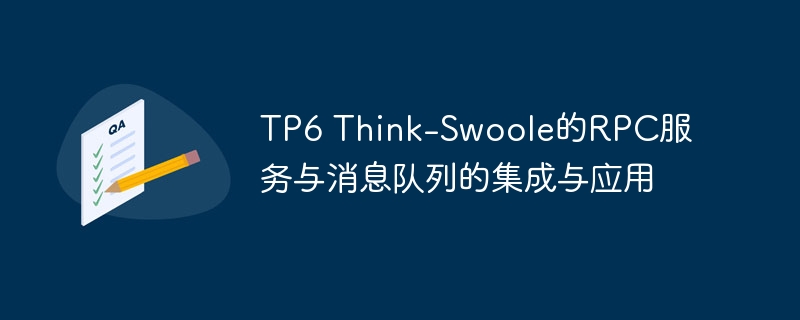Home >PHP Framework >ThinkPHP >TP6 Think-Swoole's RPC service and message queue integration and application
TP6 Think-Swoole's RPC service and message queue integration and application
- WBOYWBOYWBOYWBOYWBOYWBOYWBOYWBOYWBOYWBOYWBOYWBOYWBOriginal
- 2023-10-12 11:37:551689browse

TP6 Integration and application of Think-Swoole's RPC service and message queue
In modern software development, RPC service (Remote Procedure Call) and message queue are common Technical means for realizing service invocation and asynchronous message processing in distributed systems. Integrating Think-Swoole components in the TP6 framework can easily implement the functions of RPC services and message queues, and provides concise code examples for developers to understand and apply.
1. RPC service integration and use
- Installing Swoole extension
Before integrating Think-Swoole's RPC service, we first need to install the Swoole extension. You can use thepeclcommand or manually download the source code to compile and install. - Configuration framework file
Open theconfig/service.phpfile of the TP6 framework and add the following configuration items:
return [
// ... 其他配置项
// RPC服务配置
'rpc' => [
// 默认的RPC服务器
'default' => [
'host' => '0.0.0.0', // 监听地址
'port' => 9501, // 监听端口
'worker_num' => 4, // 工作进程数
'package_max_length' => 2 * 1024 * 1024, // 最大包长度
'open_eof_check' => true, // 开启EOF检测
'package_eof' => "
", // 包结束标记
]
],
];- Create RPC service Class
Create theTestRpcclass in theapp/rpcdirectory of the application. The code is as follows:
namespace apppc;
class TestRpc
{
public function hello($name)
{
return 'Hello, ' . $name;
}
}- Register RPC service
Open theapp/rpc/SwooleRpc.phpfile and add the following code:
namespace apppc;
use thinkswooleRpcServer;
use thinkswoolepcProtocol;
use apppcTestRpc;
class SwooleRpc extends Server
{
protected function register(): void
{
$protocol = new Protocol();
$protocol->withServices([
'TestRpc' => new TestRpc(),
]);
$this->setProtocol($protocol);
}
}- Start the RPC service
Open the terminal, switch to the application root directory, and execute The following command starts the RPC service:
php think swoole:rpc
At this point, we have successfully integrated the RPC service. You can use the RPC client to send requests to the server and receive corresponding data.
- Use RPC client
Open the controller file underappand add the following code:
namespace appcontroller;
use thinkswoolepcClient;
class Index
{
public function index()
{
$rpc = new Client('http://127.0.0.1:9501');
$result = $rpc->call('TestRpc', 'hello', ['Think-Swoole']);
var_dump($result);
return 'Hello, ThinkPHP6 + Think-Swoole';
}
}In this way, when accessing /index/index interface, a request will be sent to the RPC server through the RPC client and the result will be returned.
2. Message Queue Integration and Application
- Installing Redis Extension
Before integrating Think-Swoole’s message queue, we need to install the Redis extension. You can use thepeclcommand or manually download the source code to compile and install. - Configuration framework file
Open theconfig/swoole_http.phpfile of the TP6 framework and add the following configuration items:
return [
// ... 其他配置项
// 消息队列配置
'mq' => [
// 默认的消息队列服务器
'default' => [
'host' => 'localhost', // 主机地址
'port' => 6379, // 端口号
'auth' => 'your_password', // 密码(可选)
'db' => 0, // 数据库编号(可选)
'timeout' => 1, // 超时时间(可选)
]
],
];- Create a message queue Consumer
creates themqdirectory under theappdirectory of the application, and creates theConsumer.phpfile, the code is as follows:
namespace appmq;
use thinkswoolemqConsumerInterface;
use thinkswoolemqMessageInterface;
use thinkswoolemqMessageHandlerInterface;
class Consumer implements ConsumerInterface
{
public function consume(MessageInterface $message, MessageHandlerInterface $handler): void
{
// 根据自己的业务逻辑处理消息
$data = $message->getBody();
$handler->callback(MessageHandlerInterface::ACK);
}
} - Register message queue consumer
Open theconfig/event.phpfile and add the following configuration:
use appmqConsumer;
return [
// ... 其他配置项
// 注册消息队列事件
'subscribe' => [
'mq:TestQueue' => Consumer::class, // TestQueue为消息队列的名称
],
];- Publish message
Open the controller file and add the following code:
namespace appcontroller;
use thinkswoolemqPublisher;
class Index
{
public function index()
{
$queue = 'TestQueue';
$data = 'Hello, Think-Swoole';
Publisher::publish($queue, $data);
return 'Hello, ThinkPHP6 + Think-Swoole';
}
}In this way, when accessing the /index/index interface, the message will be published to the message queue, and the consumer will automatically receive and Process the message.
At this point, we have successfully integrated the message queue. Through the combination of publishing messages and consumers, efficient asynchronous message processing can be achieved.
Summary:
This article introduces how to integrate Think-Swoole's RPC service and message queue in the ThinkPHP6 framework, and gives specific code examples. Through these examples, we can easily use RPC services and message queues to improve system performance and scalability. I hope this article will help you understand and apply Think-Swoole's RPC service and message queue.
The above is the detailed content of TP6 Think-Swoole's RPC service and message queue integration and application. For more information, please follow other related articles on the PHP Chinese website!

